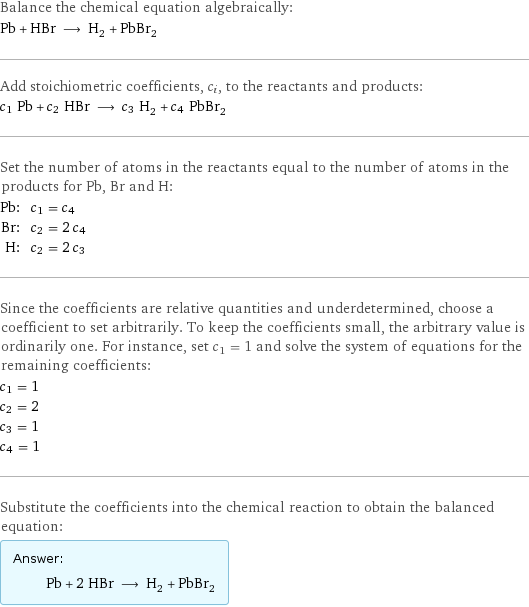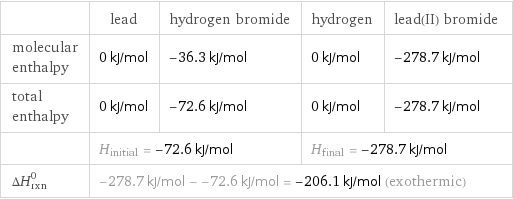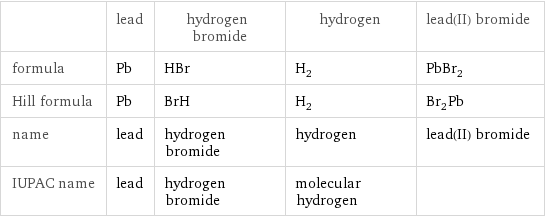Input interpretation

Pb lead + HBr hydrogen bromide ⟶ H_2 hydrogen + PbBr_2 lead(II) bromide
Balanced equation

Balance the chemical equation algebraically: Pb + HBr ⟶ H_2 + PbBr_2 Add stoichiometric coefficients, c_i, to the reactants and products: c_1 Pb + c_2 HBr ⟶ c_3 H_2 + c_4 PbBr_2 Set the number of atoms in the reactants equal to the number of atoms in the products for Pb, Br and H: Pb: | c_1 = c_4 Br: | c_2 = 2 c_4 H: | c_2 = 2 c_3 Since the coefficients are relative quantities and underdetermined, choose a coefficient to set arbitrarily. To keep the coefficients small, the arbitrary value is ordinarily one. For instance, set c_1 = 1 and solve the system of equations for the remaining coefficients: c_1 = 1 c_2 = 2 c_3 = 1 c_4 = 1 Substitute the coefficients into the chemical reaction to obtain the balanced equation: Answer: | | Pb + 2 HBr ⟶ H_2 + PbBr_2
Structures

+ ⟶ +
Names

lead + hydrogen bromide ⟶ hydrogen + lead(II) bromide
Reaction thermodynamics
Enthalpy

| lead | hydrogen bromide | hydrogen | lead(II) bromide molecular enthalpy | 0 kJ/mol | -36.3 kJ/mol | 0 kJ/mol | -278.7 kJ/mol total enthalpy | 0 kJ/mol | -72.6 kJ/mol | 0 kJ/mol | -278.7 kJ/mol | H_initial = -72.6 kJ/mol | | H_final = -278.7 kJ/mol | ΔH_rxn^0 | -278.7 kJ/mol - -72.6 kJ/mol = -206.1 kJ/mol (exothermic) | | |
Equilibrium constant
![Construct the equilibrium constant, K, expression for: Pb + HBr ⟶ H_2 + PbBr_2 Plan: • Balance the chemical equation. • Determine the stoichiometric numbers. • Assemble the activity expression for each chemical species. • Use the activity expressions to build the equilibrium constant expression. Write the balanced chemical equation: Pb + 2 HBr ⟶ H_2 + PbBr_2 Assign stoichiometric numbers, ν_i, using the stoichiometric coefficients, c_i, from the balanced chemical equation in the following manner: ν_i = -c_i for reactants and ν_i = c_i for products: chemical species | c_i | ν_i Pb | 1 | -1 HBr | 2 | -2 H_2 | 1 | 1 PbBr_2 | 1 | 1 Assemble the activity expressions accounting for the state of matter and ν_i: chemical species | c_i | ν_i | activity expression Pb | 1 | -1 | ([Pb])^(-1) HBr | 2 | -2 | ([HBr])^(-2) H_2 | 1 | 1 | [H2] PbBr_2 | 1 | 1 | [PbBr2] The equilibrium constant symbol in the concentration basis is: K_c Mulitply the activity expressions to arrive at the K_c expression: Answer: | | K_c = ([Pb])^(-1) ([HBr])^(-2) [H2] [PbBr2] = ([H2] [PbBr2])/([Pb] ([HBr])^2)](../image_source/c8435e8627ef03db468c282418e2277a.png)
Construct the equilibrium constant, K, expression for: Pb + HBr ⟶ H_2 + PbBr_2 Plan: • Balance the chemical equation. • Determine the stoichiometric numbers. • Assemble the activity expression for each chemical species. • Use the activity expressions to build the equilibrium constant expression. Write the balanced chemical equation: Pb + 2 HBr ⟶ H_2 + PbBr_2 Assign stoichiometric numbers, ν_i, using the stoichiometric coefficients, c_i, from the balanced chemical equation in the following manner: ν_i = -c_i for reactants and ν_i = c_i for products: chemical species | c_i | ν_i Pb | 1 | -1 HBr | 2 | -2 H_2 | 1 | 1 PbBr_2 | 1 | 1 Assemble the activity expressions accounting for the state of matter and ν_i: chemical species | c_i | ν_i | activity expression Pb | 1 | -1 | ([Pb])^(-1) HBr | 2 | -2 | ([HBr])^(-2) H_2 | 1 | 1 | [H2] PbBr_2 | 1 | 1 | [PbBr2] The equilibrium constant symbol in the concentration basis is: K_c Mulitply the activity expressions to arrive at the K_c expression: Answer: | | K_c = ([Pb])^(-1) ([HBr])^(-2) [H2] [PbBr2] = ([H2] [PbBr2])/([Pb] ([HBr])^2)
Rate of reaction
![Construct the rate of reaction expression for: Pb + HBr ⟶ H_2 + PbBr_2 Plan: • Balance the chemical equation. • Determine the stoichiometric numbers. • Assemble the rate term for each chemical species. • Write the rate of reaction expression. Write the balanced chemical equation: Pb + 2 HBr ⟶ H_2 + PbBr_2 Assign stoichiometric numbers, ν_i, using the stoichiometric coefficients, c_i, from the balanced chemical equation in the following manner: ν_i = -c_i for reactants and ν_i = c_i for products: chemical species | c_i | ν_i Pb | 1 | -1 HBr | 2 | -2 H_2 | 1 | 1 PbBr_2 | 1 | 1 The rate term for each chemical species, B_i, is 1/ν_i(Δ[B_i])/(Δt) where [B_i] is the amount concentration and t is time: chemical species | c_i | ν_i | rate term Pb | 1 | -1 | -(Δ[Pb])/(Δt) HBr | 2 | -2 | -1/2 (Δ[HBr])/(Δt) H_2 | 1 | 1 | (Δ[H2])/(Δt) PbBr_2 | 1 | 1 | (Δ[PbBr2])/(Δt) (for infinitesimal rate of change, replace Δ with d) Set the rate terms equal to each other to arrive at the rate expression: Answer: | | rate = -(Δ[Pb])/(Δt) = -1/2 (Δ[HBr])/(Δt) = (Δ[H2])/(Δt) = (Δ[PbBr2])/(Δt) (assuming constant volume and no accumulation of intermediates or side products)](../image_source/804a7689cd3342e482958d00f88bf57c.png)
Construct the rate of reaction expression for: Pb + HBr ⟶ H_2 + PbBr_2 Plan: • Balance the chemical equation. • Determine the stoichiometric numbers. • Assemble the rate term for each chemical species. • Write the rate of reaction expression. Write the balanced chemical equation: Pb + 2 HBr ⟶ H_2 + PbBr_2 Assign stoichiometric numbers, ν_i, using the stoichiometric coefficients, c_i, from the balanced chemical equation in the following manner: ν_i = -c_i for reactants and ν_i = c_i for products: chemical species | c_i | ν_i Pb | 1 | -1 HBr | 2 | -2 H_2 | 1 | 1 PbBr_2 | 1 | 1 The rate term for each chemical species, B_i, is 1/ν_i(Δ[B_i])/(Δt) where [B_i] is the amount concentration and t is time: chemical species | c_i | ν_i | rate term Pb | 1 | -1 | -(Δ[Pb])/(Δt) HBr | 2 | -2 | -1/2 (Δ[HBr])/(Δt) H_2 | 1 | 1 | (Δ[H2])/(Δt) PbBr_2 | 1 | 1 | (Δ[PbBr2])/(Δt) (for infinitesimal rate of change, replace Δ with d) Set the rate terms equal to each other to arrive at the rate expression: Answer: | | rate = -(Δ[Pb])/(Δt) = -1/2 (Δ[HBr])/(Δt) = (Δ[H2])/(Δt) = (Δ[PbBr2])/(Δt) (assuming constant volume and no accumulation of intermediates or side products)
Chemical names and formulas

| lead | hydrogen bromide | hydrogen | lead(II) bromide formula | Pb | HBr | H_2 | PbBr_2 Hill formula | Pb | BrH | H_2 | Br_2Pb name | lead | hydrogen bromide | hydrogen | lead(II) bromide IUPAC name | lead | hydrogen bromide | molecular hydrogen |
Substance properties

| lead | hydrogen bromide | hydrogen | lead(II) bromide molar mass | 207.2 g/mol | 80.912 g/mol | 2.016 g/mol | 367 g/mol phase | solid (at STP) | gas (at STP) | gas (at STP) | solid (at STP) melting point | 327.4 °C | -86.8 °C | -259.2 °C | 371 °C boiling point | 1740 °C | -66.38 °C | -252.8 °C | 892 °C density | 11.34 g/cm^3 | 0.003307 g/cm^3 (at 25 °C) | 8.99×10^-5 g/cm^3 (at 0 °C) | 6.66 g/cm^3 solubility in water | insoluble | miscible | | surface tension | | 0.0271 N/m | | dynamic viscosity | 0.00183 Pa s (at 38 °C) | 8.4×10^-4 Pa s (at -75 °C) | 8.9×10^-6 Pa s (at 25 °C) | 0.0088 Pa s (at 382 °C) odor | | | odorless |
Units
